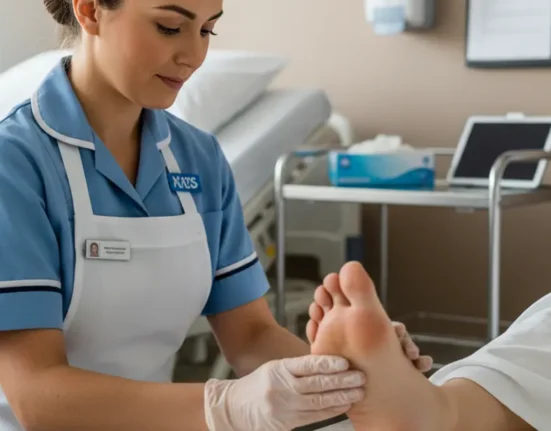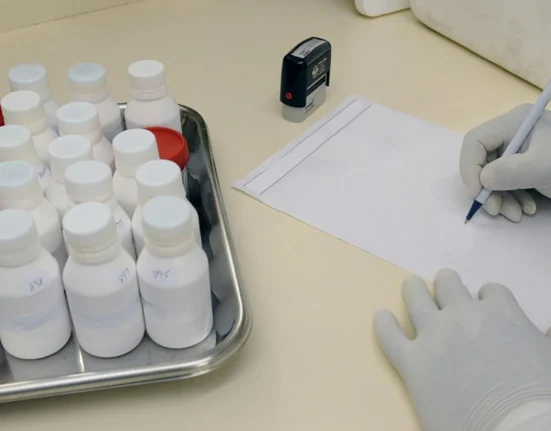The difference between community and hospital NMC OSCE assessments lies primarily in their focus, setting, and approach due to the unique needs of patients in each environment.
To proceed effectively in the NMC OSCE Assessment station in both community and hospital settings, follow a structured approach while tailoring your actions to the specific environment. Here’s a step-by-step guide for each setting:
| Elements | Community | Hospital |
| Identification of Patient | · Check Name, date of birth, Address and Allergy status verbally and match with scenario paper given and acknowledge you are with correct patient | Check Name, date of birth, Address and Allergy status with wrist band and Scenario paper given and acknowledge you are with correct patient |
| Setting and Context | Conducted in patients’ homes, clinics, or other community-based settings. Focuses on holistic care, including social, environmental, and psychological factors. Emphasizes long-term management, health promotion, and prevention. | Conducted in an inpatient or outpatient hospital setting. Primarily focused on acute or critical care needs. Prioritizes stabilization, diagnosis, and treatment of immediate medical concerns. |
| Approach to Care | Person-centered, with an emphasis on supporting independence. Includes a broader view of the patient’s lifestyle, family dynamics, and living conditions. Often involves interdisciplinary collaboration (e.g., with social workers or community health workers). | Task-oriented and focused on clinical interventions. Concentrates on physical health, using technology and investigations to monitor and manage conditions. Requires close monitoring for sudden changes in the patient’s condition. |
| Assessment Goals | A-E Assessment remain same regardless of setting | A-E Assessment remain same regardless of setting |
| Scope of the Assessment | Promotes wellness and addresses health inequalities. Manages chronic diseases and coordinates resources (e.g., medications, mobility aids).Focuses on prevention and education. | Aims to diagnose and treat acute or severe conditions. Focuses on stabilization, recovery, and discharge planning. Ensures patient safety and monitors for complications. |
| Follow-Up and Continuity | Re-assess patient on basis of score of vitals on chart. Instruct to call GP or 999 if any concern or help required | Re-assess patient on basis of score of vitals on chart. Instruct to use call bell if any concern or help required |

Steps to follow while performing NMC OSCE Assessment station in Exam:
NMC OSCE Assessment station; Preparation
- Review the NMC OSCE Assessment Scenario carefully.
- Focus on present complain and allergy status of the patient
NMC OSCE Assessment station; Assessment Steps
- Introduction:
· Ensure Scene safety, privacy and 7 steps of Hand hygiene before approaching patient.
- Introduce yourself and explain the purpose of the assessment.
- Verify patient identity (name, DOB, hospital ID/community Address).
- Consent:
- Obtain verbal consent before proceeding.
- Address any concerns the patient may have.
- Collect required articles for the procedure and ensure integrity of all articles.
- Perform a Systematic Assessment:
- A-E Approach:
- A (Airway): Check if the airway is clear.
- B (Breathing): Assess respiratory rate, oxygen saturation, Respiratory Noises and sign of distress and unequal air entry.
- C (Circulation): Monitor pulse, blood pressure, and capillary refill and Pallor and perfusion
- D (Disability): Evaluate consciousness level using AVPU (Alert, Voice, Pain, Unresponsive). Ask last blood glucose level, pain and Urine Output.
- E (Exposure): Inspect for rashes, wounds, or abnormalities, Temperature and Medical history.
- A-E Approach:
- Document Findings:
- Record vital signs, clinical observations, and patient responses accurately.
- Communicate:
- Escalate concerns promptly to the appropriate team.
- Share your findings and action plan with the patient.
6. ;Holistic Assessment:
- Physical Health:
- Ask concern as per scenario Ex. Food intake, Sleeping Pattern etc.
- Assess symptoms and ongoing health conditions.
- Psychosocial:
- Ask as per scenario about family or any habit of concern etc
- Spiritual:
- Ask if they want any arrangement regarding spiritual need
- Gender Comfort:
- Ask do they have any gender preference while receiving care.

- Plan of Action:
- Educate the patient about managing their health conditions.
- Referrals and Follow-Up:
- Make necessary referrals if required (e.g., social workers, physiotherapists).
9. Closing
· Ensure to check patient comfort and concern.
· Ensure patients have access to call bell / emergency contacts and resources if required.
Both types of NMC OSCE Assessments are essential and complementary, ensuring comprehensive care for individuals in different stages of health and settings. By adapting your approach based on the setting, you can deliver high-quality care tailored to the patient’s needs during NMC OSCE Assessment.
Enhance Your NMC OSCE Preparation
Our comprehensive OSCE training is designed to help you excel in the NMC OSCE exam. With tailored guidance, practice scenarios, and expert support, we ensure you’re fully equipped with the skills and confidence to succeed. Sign up for our OSCE course today and take your preparation to the next level! Also, check out the guide to prepare for NMC OSCE.
NMC OSCE For nurses Everything You Need to Know in 2024 👉 Click Here
For Any NMC OSCE Related Queries and Training Chat with Us!














Leave feedback about this